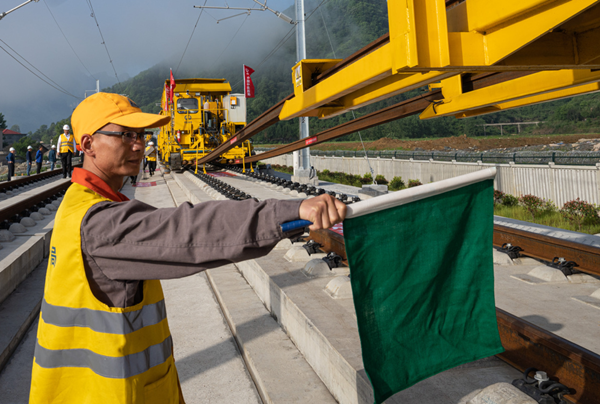Smart Tech Boosts 'Most Beautiful Rail'

A CTCE employee signals while 500-meter-long ballastless tracks, part of the Zhangjiajie-Jishou-Huaihua High-speed Railway, are laid over the weekend. The project is supported by smart track-laying facilities, which help in reducing manpower and expediting project work. [Photo by Wu Huaiqiu/For China Daily]
The 246-km Zhangjiajie-Jishou-Huaihua high-speed line to wrap up by year-end
China Tiesiju Civil Engineering Group (CTCE), a State-owned construction behemoth, used the country's first intelligent track-laying facilities to lay a pair of 500-meterlong ballast-free track segments on Saturday for a 38.24 billion yuan ($5.92 billion), 246.6-kilometer high-speed railway line.
The Zhangjiajie-Jishou-Huaihua High-speed Railway, which is nearing completion, traverses the Wuling Mountains, which stretch across Central China and Southwestern China.
The railway will link three cities in western Hunan province, and benefit from the intelligent complex composed of four sets of equipment developed by the 70-year-old CTCE.
The railway line will have eight stops, numerous bridges and mountain tunnels, and trains can reach speeds of up to 350 kilometers per hour, and benefit some 7.85 million residents in the mountainous area, said Song Heng, a CTCE publicity official.
At the order of Duan Qinan, a chief engineer from CTCE Eighth Engineering Co Ltd, which carried out the project, three drivers operated the long-rail intelligent sorting vehicle, push and roller recovery vehicle, and the tractor for the WPZ-500 Model facility, respectively, in close coordination, to nimbly lay the pair of railway tracks with great precision.
The operation was witnessed by a large group of select invitees comprising industry representatives.
"The project began in 2019, and its successful operation now gives us great confidence," said Zhai Changqing, Duan's colleague and a master engineer who oversees its development.
It will be especially useful in special areas with high altitudes, low temperatures and where laborers are in short supply, Zhai said.
Compared with traditional methods, the smart track-laying technology can help save some 63 percent on on-site laborers, upgrade the degree of track-laying mechanization to 90 percent, while also reducing damage to construction materials, he said.
"If it is used in building the Sichuan-Tibet high-speed railway in the future, the gains in saving manpower, boosting speed and reducing material damage will be enormous."
Duan said the smart technology fills a void and demonstrates CTCE's endeavor to meet China's strategic call for intelligent construction and high-quality development during the 14th Five-Year Plan period (2021-25).
CTCE has been following parent company China Railway Group Ltd's new focus on digital and intelligent construction, and intends to be a pioneer in the new sphere, he said.
During the past few years, CTCE Eighth Engineering has set up the "National Model Worker Zhai Changqing Innovation Studio". It also formed a team to pursue joint studies, research and development, production and application of new breakthroughs in building the Zhangjiajie-Jishou-Huaihua High-speed Railway, said Xu Guo, publicity chief of CTCE.
The WPZ-500 unit has made full use of some cutting-edge technologies like intelligent robots, the internet of things, big data, laser scanners for precise positioning and AGV (automated guided vehicle) automatic tracking, Duan said.
It can now complete a series of work processes, covering precise traction and pushing of long rails, precise placement and automatic recovery of rollers on the railway line, stacking and reverse transportation, he said.
Duan said CTCE has applied for 17 invention and utility model patents by centering on the WPZ-500 model and has been accepted by the China National Intellectual Property Administration for patent applications.
By working with Central South University based in Changsha, Hunan province, and Zhuzhou Xuyang Electromechanical Technology Development Co Ltd for almost two years with an input of some 20 million yuan, the model is now a success, said Duan.
Covering western Hunan, western Hubei, southeastern Chongqing and eastern Guizhou, the mountain range runs for some 420 km, 70 percent of which are areas with an altitude of over 800 meters above sea level, he said.
The line links a cluster of scenic spots with stunning views. It has the Zhangjiajie Wulingyuan, a top-rated UNESCO World Heritage site and global geopark, in the north, and Phoenix Ancient Town in the middle.
The railway, which is part of country's efforts to reduce local poverty, is dubbed the "most beautiful high-speed railway in China", helping boost local transport and draw more visitors.
Construction started in September 2019, and will be completed within this year, connecting seven counties, cities and districts in the area, and cutting travel time from three-and-a-half hours to just around an hour.
The main works of the railway have been completed already, said Song.
Li Zhuowei, a vehicle driver for the WPZ-500 facility, said he is delighted to operate the new equipment that helps boost the construction of the high-speed railway.
"When the railway starts train services, I will take a ride and try to enjoy the beautiful scenery on both sides of the line," Li said.
